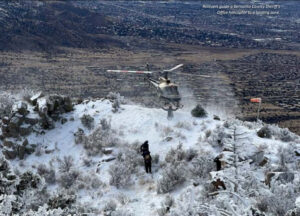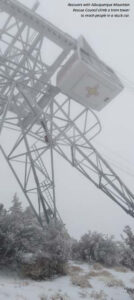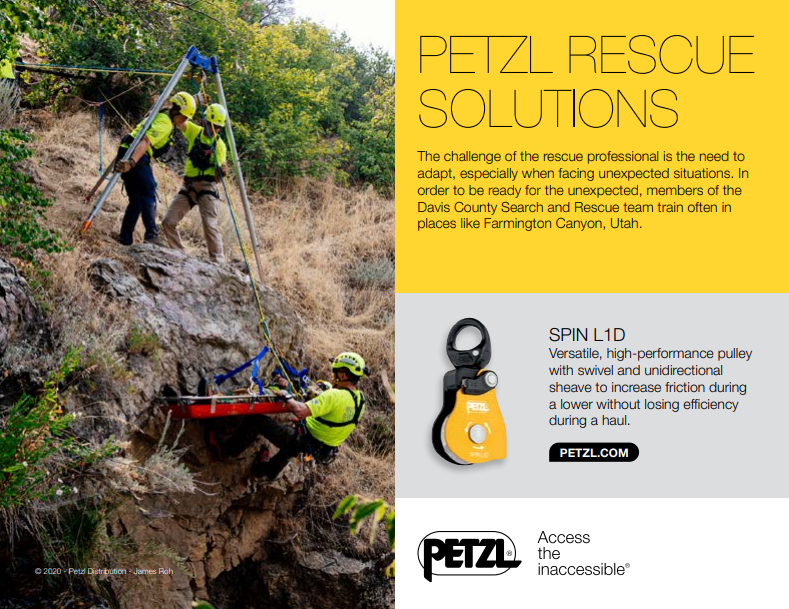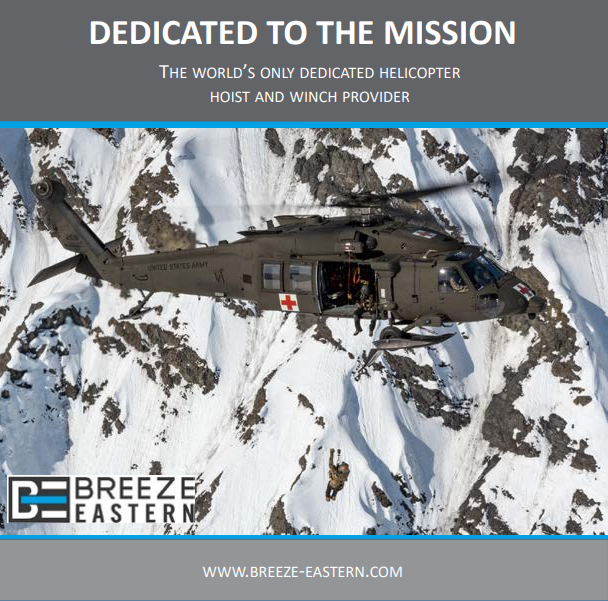By Steve Larese – Meridian Editor
Albuquerque, N.M. – At 0400 on January 1, 2022, Albuquerque Mountain Rescue Council members were awakened by their callout tones and blinked blearily at their phones:
“MSN #1. TRAM STUCK AT TOWER 2. 21 PATIENTS NEED SUPPLIES…NEED RESPONDERS ASAP.”
“I assumed there was a typo in the pageout at first because a mission with 21 patients seemed impossible,” said AMRC member Jay Johnson, who would lead the second of two teams into the field. “But then I realized the severity of what was happening and started running worst-case scenarios through my head.”
It isn’t difficult to think of several worst-case scenarios when it comes to emergencies involving the Sandia Peak Aerial Tramway. The 2.7-mile long “jig-back” tram is the world’s third longest single-span tram. Two cars carrying as many as 50 people each travel between the tram base at 6,559 feet and the top terminal at 10,378 feet atop the Sandia Mountains just east of Albuquerque. The cables are supported by two towers in-between the terminals, and each 15-minute “flight” passes over canyons that can plummet 1,000 feet below the cars. The towers are in such rugged terrain that they were erected piece by piece via helicopter in 1966.
AMRC Rescue Leader Craig Tenney and EMT Jesse Olson were among the first four AMRC personnel to reach the incident base at 0500. They learned that the 21 people were all tram employees or worked at Ten 3, a restaurant next to the top terminal. A car of 20 employees was descending at about 2200 on December 31, and a car with one employee prepared to spend the night per standard procedure was traveling up. Ice had built up on an emergency cable, and weighed it down into the track cables. A safety system engaged and stopped the tram. Tram workers were able to inch the tram car to Tower 2, at which point the car was only 60 feet above the small piece of land surrounded by inhospitable mountain wilderness. Still, employees were dressed for work, not mountaineering in a snow storm. Some employees were dressed for a hot kitchen, with some even wearing Crocs. Aboard the unheated car was a portable toilet and some Mylar blankets, and employees began sharing and rationing candy. Despite 20 bodies backed together in the space, temperatures in the 20s quickly chilled the car, and condensation began dripping from the ceiling.
The car was illuminated by the glow of phones as employees posted about their predicament on social media and half-heartedly welcomed the new year. At 0200 January 1, Sandia Peak Aerial Tramway owner Benny Abruzzo called 911.
“So, I’m at Sandia Peak Tramway and we have a situation here,” he told the 911 operator. “We can’t get them all the way back to the terminal. We’re in a situation where we may need some ground help. It’s not practical to do the air help which is what we’ve all been training for. It’s, of course, nighttime.”
Spencer Moreland, an incident commander for New Mexico Search and Rescue, received a call from the New Mexico State Police at 0300. He was on the scene by 0400 and the callout was made.
By 0500, the four-member AMRC Team One was trudging up four miles of steep terrain in a snowstorm joined by Abruzzo, himself an accomplished outdoorsman, and another capable tram employee. Snow streaked through headlamp beams as the six picked their way to cloud-obscured Tower 2.
“One good thing was that all of the cactus spines were covered in ice, so that afforded us some protection,” Tenney optimistically recalls. “We appreciated any advantage we had.”
Team One deployed with technical gear and a few pairs of boots for the employees. With helicopters grounded, Tenney began developing a plan. His team would scale Tower 2 and lower patients to the ground 60 feet below. A Cibola SAR and AMRC team led by Johnson were carrying more boots, clothing and supplies. They would lead the lowered employees out, setting up hand lines along the way. It would be arduous, but it was the safest plan to get everyone home. Employees were getting desperate, temperatures in the car were dropping, and it would be days before the tram would be safety checked and operational again.
After several hours of picking a four-mile route with 2,100 feet of elevation gain through snowy outcrops and canyons, Team One reached the base of the 200-foot sloped peak, the last 30-feet of which are a Class 4 climb. Above that stood Tower 2 and the stranded employees.
“Throughout the hike to the tower, we were gaining information on what to expect,” Olson said. “We had carefully chosen the equipment we were each carrying to ensure we had the right mix of gear. We knew the final approach below the tower would likely require some ropes to safely ascend, and we would obviously need another rope to lower people from the tram car.”
Olson made the icy climb and anchored a rope to help the others. Looking up, the team saw the icy 80-foot tower disappearing into cloud cover. Making it over to the base of the tower, Abruzzo took the lead in climbing it, showing the other team members the best approach.
“The tower was coated in ice, and the first rung of the access ladder was over our heads,” Tenney says. “It took some gymnastics with bulky gloves and heavy packs to just get on the ladder. We used two points of attachment on our harnesses, like a via ferrata, to climb the rungs to the platform where we could enter the car from the top emergency hatch.”
The team carefully spanned the gap between the icy tower and the top of the car and opened the hatch. Cheers went up from the employees on board.
“The patients were very excited to see us,” Olson says. “The car was highly crowded and everyone was in good spirits. We performed medical assessments on everyone. Most people were a bit cold and hungry, but there were no immediate concerns.”
“The condensation was just raining down from the ceiling,” Tenney says. “I was concerned we’d have wet patients before we even left the car.”
The rescuers had made it in, but now how would they get everyone out? None of the AMRC members on scene had set up a lowering system in a tram car before, but using the fundamental principles of safe rope rigging, they were quickly able to set up a safe system. They tied an anchor to the structural beams on the tram roof. These anchor ropes draped over the edge of the roof and dangled in front of the double sliding door, eye level to a person in the tram. This anchor supported two belay devices and ropes that allowed rescuers to safely lower patients out the door. Inside the tram car, floor-to-ceiling poles served as safety points for tie-ins. Rescuers turned restaurant service on board onto their sides to make barriers to ensure only those tied to the poles would be near the open tram door.
“Many people are scared of heights, and the door of the tram car is not necessarily an easy exit for someone without experience going over an edge,” Olson says. “Two members of AMRC were lowered first to show the patients how to exit the car and to ensure there were assisting personnel on the ground as the patients were lowered. Some of the patients expressed minor fears, but after being trapped in the car for 15 hours they were so eager to leave that they were quickly overcome. The safety margins on the rescue rigging are incredibly high, so a simple demonstration and explanation of the system put minds at ease.”
In the hour it took to rig the lowering system, luck continued to improve for the rescue. A lull in the storm lifted the cloud ceiling, making safe enough conditions to use helicopters. What was going to be possibly the most dangerous part of the rescue–an hours-long hike with subjects through bad weather in demanding mountain terrain–was now going to be a 5-minute helicopter ride.
A small, relatively flat area about 200 feet from the tower was designated as a landing zone for a Bernalillo County Sheriff’s Office’s helicopter piloted by Undersheriff Larry Koren. Employees donned harnesses in helmets, then the rescuers gently lowered them out of the car to the ground where AMRC members took them off harness and transferred them to the helicopter’s flight medic. Employees were clipped in two at a time for the quick flight back to Incident Base, allowing enough time for two more employees to be lowered. After an hour, all of the 20 employees were safely back at the incident base. Focus shifted to the lone employee of the second car, who was rescued without incident.

With all of the subjects safe, rescuers began making a long but upbeat hike back to incident base. The route was better defined in the tramped snow, and morale was high knowing the mission was successful. The two other teams carrying gear, while not used, linked up with the main group and were happy that all of the subjects were safe.
By the time all teams were out of the field, the media had picked up the story. Videos taken by the employees from inside the tram car, observers using telephoto lenses to take video and photos and even body camera video from the Sheriff’s office were soon being shared by media outlets nationwide. ABC and the New York Times ran articles.
Tenney says that while there’s no way to completely train for a mission such as this, the dedication of AMRC members in their training and adventures on their own in winter conditions contributed to the mission’s success.
“I was surprised at how much attention this mission received, but I guess a dramatic, successful rescue mission made for a great feel-good piece for the start of 2022,” Tenney says. “But compared to some of our other missions, this one was pretty straight forward. It’s a real testament to our training, having the basics dialed in, being able to improvise and to work well with other agencies. It’s what we do to get people home safe.”
Photos
Tram Cover Image: Rescuers climb a tower to rescue people stuck in a tram near Albuquerque, N.M. on January 1, 2022.
Tram Cloud: Rescuers with Albuquerque Mountain Rescue Council climb a tram tower to reach people in a stuck car.
Chopper Snow: Rescuers guide a Bernalillo County Sheriff’s Office helicopter to a landing zone.




